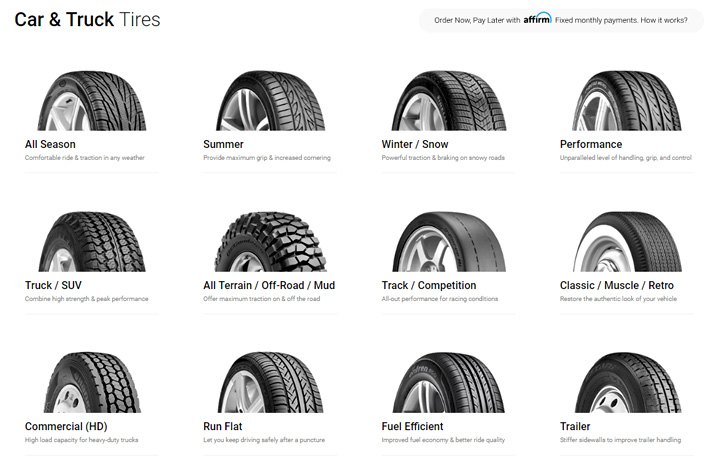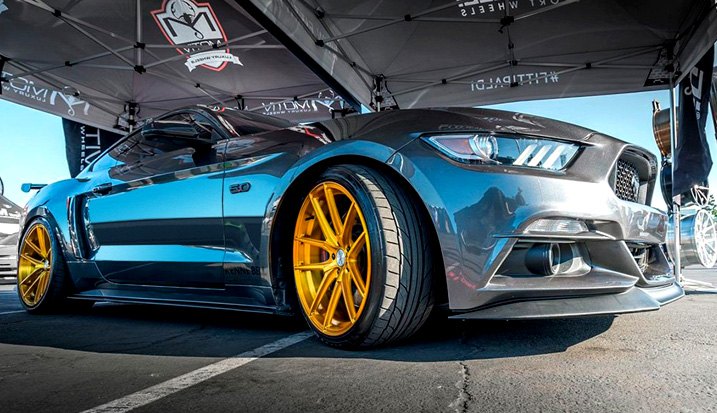The purchase of a new set of tires for your car or truck is a considerable monetary outlay. Depending on the type of vehicle and the tire size, a set of four new tires could cost anywhere from several hundred to several thousand dollars. And this is before you add in the labor cost to mount and balance them!

It naturally occurs to many purchasers to ask, how long should tires last? To be more specific, the question is "How many miles of driving should I expect to get from my new tires?" Expected tire wear varies among tire brands and models. But once the tires are on the car, other influences come into play. We will take a look at the factors which influence tire wear, and best practices the vehicle owner can implement to maximize tire life.
In this article, we will make several presumptions: first, the article will presume that the owner is in the market for new, and not used tires. It's virtually impossible to address the remaining service life on used tires when we don't know their age or miles they've been used. Second, this article will presume that new tires will reach the end of their useful service life based on mileage and not time. While it's true that lower annual mileage theoretically means your tires will last longer, at some point, the age (and accompanying rubber deterioration) will require tire replacement, even if most of the tread remains. That average age is around 7-8 years, longer if the car is stored under cover, shorter if the tires have greater exposure to the sun's UV rays.
Tire Treadwear Ratings & Warranties
As we address in our related article "When Is it Time To Replace My Tires?", Federal law in the U.S. requires all passenger tires to carry a Uniform Tire Quality Grade (UTQG) rating, which rates tires for Treadwear, Traction, and Temperature. The Treadwear Rating is the first part of the UTQG, expressed as a number (Traction and Temperature Ratings are indicated by letters). The Treadwear Rating is a relative number, based on how the tire to be rated wears compared to a baseline tire always rated at 100.
Think of it this way: a tire rated at 200 should last twice as long as the base tire; a tire rated at 400 should last four times as long. We can conclude that the higher the Treadwear Rating, the longer the tire should last. But also keep in mind that tires with high Treadwear Ratings may be composed of harder rubber which can give a harsher and noisier ride.

Many tire manufacturers also provide a pro-rated treadwear warranty. The typical warranty provides a credit toward the purchase of new tires of the same brand. While such warranties can provide peace of mind and should be part of the buying decision, ultimately, treadwear can and does vary greatly from vehicle to vehicle and from driver to driver.
It is our recommendation that treadwear should be but one factor to consider when you're ready to buy. Tread pattern, speed and load ratings, brand reputation, and of course cost should also be taken into consideration. If there are questions, please consult with a tire expert either at CARiD's Wheels & Tires Department, or with a tire retailer local to you.
Factors Which Influence Tire Wear
Treadwear warranty or not, tire manufacturers have no control over what happens once their donut-shaped pieces of rubber are mounted on your ride. I've been first-hand witness to two identical cars, mounted with identical tires, but driven by two different owners, where one car got 60,000 miles from its tires, and the second car needed new rubber at 20,000 miles. Obviously, external factors are at play.
Driving Style Factors Which Influence Tire Wear
Since tires are the only contact point between your vehicle and the pavement, the steering, handling, and braking have an influence on, and are influenced by, the tires. Aggressive driving, such as jack rabbit starts, hard braking, and fast cornering, literally put more pressure on these contact points and create friction, heat, and wear. Conversely, gradual acceleration, moderate braking, and slow cornering all minimize the amount of rubber which is scrubbed off the tires. While sporty driving is fun, especially if you have a sporty car, the tradeoff is more rapid tire wear.

The weight of the vehicle also plays a role. The heavier the car or truck, the more pressure is put on the contact points, and the more likely it is that tires will wear. While you cannot change the weight of your engine or suspension, you can be mindful of the cargo you're carrying. Check the rear seat floor and the trunk/cargo hold: are you carrying around items that do not need to be in the car? A tool box, set of golf clubs, or unneeded baby seats all are weight that adds up. Removing these non-essential items will save your tires some wear, and will help your fuel mileage too.
Maintenance Factors Which Influence Tire Wear
Regular maintenance on a modern car includes oil and filter changes, cabin air filter replacement, and not much else, correct? Actually, there are some straightforward but important maintenance steps which will help with longer tire tread life.

Your vehicle manufacturer's maintenance schedule may or may not include these steps, so it's important for you as the car owner to remain vigilant. First is a regular check of tire pressure. As we recommend in our article Checking and Adjusting Your Vehicle's Tire Pressure, pressures should be checked about once a month, more often if you drive more. Tires which are underinflated OR overinflated will wear prematurely. Your vehicle manufacturer knows best: set the tires to the pressures as printed on the Tire Pressure Label.

Next, be sure to include tire rotation in your regular service schedule. Tire rotation evens out any wear differences between the front and rear tires. Front tires do all the steering, and take on the majority of the load in hard cornering. Acceleration forces depend on whether the vehicle is front wheel drive (FWD), rear wheel drive (RWD), or all wheel drive (AWD). Braking puts its biggest load on front tires.
A good rule-of-thumb is to rotate tires at every oil change; these days, about every 10,000 miles. (This is also an ideal opportunity to check brake pad wear). If you have a floor jack and a pair of jack stands, you can do the rotation yourself. If you're servicing your vehicle at a dealership or independent repair shop, ask to ensure that it's being done. Some shops include it at no extra charge, hoping to offer other needed service that's identified, like brake work.

Compared to the good old days when cars had full size spares, most manufacturers do not include the spare tire in the rotation scheme, as it's a lightweight temporary spare designed for only occasional use. Follow the vehicle maker's rotation pattern; if there isn't one, rotate the tires from front to rear and rear to front, keeping them on the same side (left or right) of the vehicle.
The final maintenance factor to mention is alignment. Out-of-spec alignment can cause abnormal tire wear. As part of the vehicle's rotation schedule, tread wear should be checked for any sign of abnormality. This could be an indication that an alignment is in order. (It is simply not true that hitting a pothole causes the alignment to be knocked out of spec. An incorrect alignment is almost always the result of gradual long-term deterioration and wear to steering and suspension components.)
There is no hard and fast rule regarding the frequency of alignment correction. Some may say once a year; others, once every 3-4 years. For the driver/owner, the best advice is to pay attention to the way the car operates: does it pull to one side? Is the steering or handling less accurate? Is the tread showing signs of uneven wear? Any of these could point to the need for an alignment. Many modern vehicles make accommodation for the rear tires to also be aligned. If so, it's called a four-wheel-alignment, as opposed to just front-wheel-alignment.
Both your driving habits and your adherence to a regular maintenance schedule will pay big dividends if your goal is to maximize tire life. Stay attuned to what your ride is telling you; if you're fortunate enough to have a trustworthy repair shop, depend on them for advice. Taken all together, you can look forward to many thousands of miles of safe and happy driving on your new tires.
